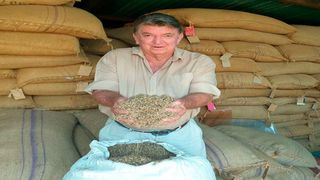
Robert Murrey displays buffel grass seeds in Baringo County.
Buffel grass, the untapped gold of semi-arid regions
A ride in a boat across Lake Baringo is both scary and exhilarating. Scary because the lake is infested with crocodiles while exhilarating because of the magnificent view that the ride offers.
It takes about 15-20 minutes to cross to the other side of the lake in the boat. Our destination is the home of Robert Murrey.
Murrey, who runs Rehabilitation of Arid Environments (RAE) Trust, grows Buffel grass, harvests its seeds for sale as well as distribute to members of the community.
Having grown up at his father’s Roberts Camp, which is within the lake, Murrey says he has always thought of coming up with a solution to help the pastoralists access pasture.
"I started trials on different grasses, and liked Buffel the most because of its resilience to harsh weather conditions," says Murrey. Buffel grass is scientifically known as Cenchrus ciliaris. The Ilchamus call it Lhogorr aingok and the Tugens Lhomer kwan.

A buffel grass field.
Locals say the grass has grown in the region for ages in areas such as Arabal, Koriema, Mukutani and Kokwa Island in the heart of Lake Baringo.
Geoffrey Letakaan, 63, says they did not know the value of the grass; that they can trade in its seeds and hay.
“I got the initial seeds from Roberts Camp in the heart of Lake Baringo where my father lived. After research, I started to harvest seeds. The grass is registered as Baringo,” says Murrey, who is hoping to register about five more varieties.
Inside his makeshift store, Murrey has bags of seeds, each filled with 10 kilos of seeds.
“This grass is key to not only empowering pastoral communities, but also in helping to solve conflict and cattle rustling cases which are rampant in the area.”
Murrey works with about 900 farmers as out-growers, mainly in Baringo and Tiaty, with the farmer producing 10 tonnes annually.
A kilo of buffel grass seeds goes for between Sh300-Sh700, with the farmer selling the grass locally and in countries like Somalia. To grow the grass, one ploughs the land and then broadcasts the seeds.
“This grass mostly thrives in dry areas and can therefore be grown in Northern as well as eastern Kenya,” he says.
“It needs a hot and humid environment. It does well in hot areas, but sprouts under wet conditions during the rainy season.” A number of locals have embraced farming of the grass.
At Salabani village, 25 members of Nooseiya community based organisation grow the grass for seeds and hay.

Francis Toroitich shows baled buffel grass.
“To us, buffel grass is our gold. It is our cash crop, just like coffee or tea in other areas,” says Francis Toroitich, the group’s chair.
Toroitich says the grass is a solution to unreliable and tiring pastoralism.
“We have suffered for long due to lack of pasture, amid effects of climate change and land degradation but we are now diversifying to grass seeds and hay production,” says Toroitich.
The group jointly grows buffel grass on 50 acres, harvesting an average of 1.2 tonnes of seeds annually, which they sell at Sh300 per kilo.
Their main market is the Kerio Valley Development Authority, a government agency, which buys buffel grass seeds and also bales its hay.
Dry season
The baled grass is stored for members to use during the dry season, while the excess is sold for between Sh250-350 per bale, according to Toroitich.
George Ogendi, an associate professor of environmental health and the director of Egerton University’s Chemeron Dryland Research Training and Ecotourism Centre, says the grass is tolerant to drought, therefore suitable for arid and semi-arid lands.
“The grass is taller than other varieties, drought-resistant and has a high protein content of 12 percent. Protein is the most vital nutrient, making buffel grass a bit ‘superior’. Additionally, the grass is sweet, therefore, loved by livestock,” he says, adding its deep roots enhance crop stability and allows the grass to reach deep waters and retain moisture for longer.
He notes buffel grass seeds are highly marketable and can offer additional income to communities living in dry lands. “This grass is versatile, it can also be utilised for thatching houses.”





